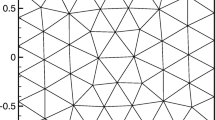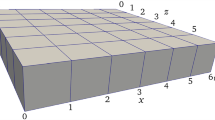Summary
The topic of iterative substructuring methods, and more generally domain decomposition methods, has been extensively studied over the past few years, and the topic is well advanced with respect to first and second order elliptic problems. However, relatively little work has been done on more general constrained least squares problems (or equivalent formulations) involving equilibrium equations such as those arising, for example, in realistic structural analysis applications. The potential is good for effective use of iterative algorithms on these problems, but such methods are still far from being competitive with direct methods in industrial codes. The purpose of this paper is to investigate an order reducing, preconditioned conjugate gradient method proposed by Barlow, Nichols and Plemmons for solving problems of this type. The relationships between this method and nullspace methods, such as the force method for structures and the dual variable method for fluids, are examined. Convergence properties are discussed in relation to recent optimality results for Varga's theory ofp-cyclic SOR. We suggest a mixed approach for solving equilibrium equations, consisting of both direct reduction in the substructures and the conjugate gradient iterative algorithm to complete the computations.
Similar content being viewed by others
References
Bank, R., Welfert, B., Yserentant, H.: A class of iterative methods for solving saddle point problems. Preprint, Dept. Math., UCSD, 1989
Barlow, J.: Error analysis and aspects of deferred correction for equality constrained least squares problems. SIAM J. Numer. Anal.25, 1340–1358 (1988)
Barlow, J., Nichols, N., Plemmons, R.: Iterative methods for equality constrained least squares problems. SIAM J. Sci. Stat. Comput.9, 892–906 (1988)
Berry, M., Plemmons, R.: Algorithms and experiments for structural mechanics on high performance architectures. Comput. Methods Appl. Mech. Eng.64, 487–507 (1987)
Bjorck, A.: Least squares methods. In: Ciarlet, P., Lions, J. (eds.) Handbook for numerical methods, vol. 1. Elsevier/North Holland 1989
Eiermann, M., Niethammer, W., Ruttan, A.: Optimal successive overrelaxation iterative methods forp-cyclic matrices. Numer. Math.57, 593–606 (1990)
Freund, R.: A note on two block-SOR methods for sparse least squares problems. Linear Algebra Appl.88–89, 211–221 (1986)
Golub, G., de Pillis, J.: Toward an effective two-parameter SOR method. Preprint, Computer Sci. Dept., Stanford, 1988
Hall, C.: Numerical solution of Navier-Stokes problems by the dual variable method. SIAM J. Algebraic Discrete Methods6, (No. 2) 220–236 (1985)
Huston, R., Passerello, C.: Finite element methods. New York Basel: Marcel Dekker 1984
James, D.: Ph. D. Dissertation, Dept. Mathematics, North Carolina State Univ. Raleigh, NC (1990)
Kaneko, I., Plemmons, R.: Minimum norm solutions to linear elastic analysis problems. Int. J. Numer. Methods Eng.20, 983–998 (1984)
Markham, T., Neumann, M., Plemmons, R.: Convergence of a direct-iterative method for large scale least squares problems. Linear Algebra Appl.69, 155–167 (1985)
Neithammer, W., de Pillis, J., Varga, R.: Convergence of block-iterative methods applied to sparse least squares problems. Linear Algebra Appl.58, 327–341 (1984)
Pierce, D., Hadjidimos, A., Plemmons, R.: Optimality relationships forp-cyclic SOR. Numer. Math.56, 635–643 (1990)
Plemmons, R.: A parallel block iterative scheme applied to computations in structural analysis. SIAM J. Algebraic Discrete Methods7, (No. 3) 337–347 (1986)
Plemmons, R., White, R.: Substructuring methods for computing the nullspace of equilibrium matrices. SIAM J. Matrix Anal. Appl.11, 1–22 (1990)
Stoer, J.: On the numerical solution of constrained least squares problems. SIAM J. Numer. Anal.8, 382–411 (1971)
Strang, G.: A framework for equilibrium equations. SIAM Rev.30, (No. 2) 283–297 (1988)
Strang, G.: Introduction to applied mathematics. Wellesley, MA: Wellesley Cambridge Press 1986
Varga, R.:p-cyclic matrices: a generalization of the Young-Frankel successive overrelaxation scheme. Pac. J. Math.9, 617–623 (1959)
Varga, R.: Matrix iterative analysis. Englewood Cliffs, NJ: Prentice-Hall 1963
Young, D.: Iterative methods for solving partial differential equations of elliptic type. Trans. Am. Math. Soc.76, 92–111 (1954)
Author information
Authors and Affiliations
Additional information
Dedicated to R. S. Varga on the occasion of his 60th birthday
Research completed while pursuing graduate studies sponsored by the Department of Mathematical Sciences, US Air Force Academy, CO, and funded by the Air Force Institute of Technology, WPAFB, OH
Research supported by the Air Force under grant no. AFOSR-88-0285 and by the National Science Foundation under grant no. DMS-89-02121
Rights and permissions
About this article
Cite this article
James, D., Plemmons, R.J. An iterative substructuring algorithm for equilibrium equations. Numer. Math. 57, 625–633 (1990). https://doi.org/10.1007/BF01386432
Received:
Issue Date:
DOI: https://doi.org/10.1007/BF01386432




